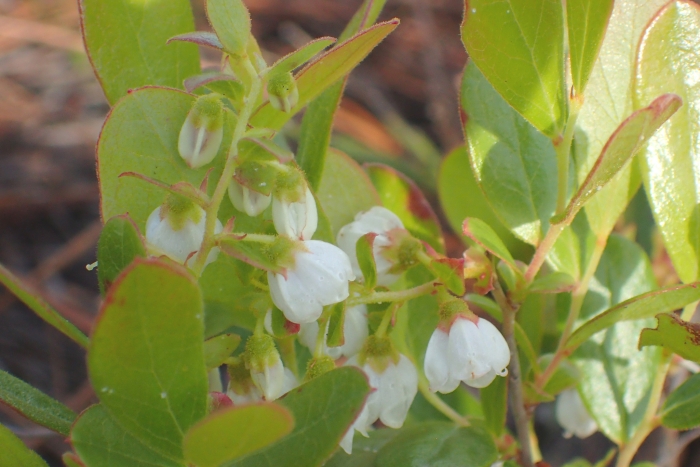Dwarf Huckleberry
(Gaylussacia dumosa)
Dwarf Huckleberry (Gaylussacia dumosa)
/
/

Austin Pursley
Public Domain
Image By:
Austin Pursley
Recorded By:
Copyright:
Public Domain
Copyright Notice:
Photo by: Austin Pursley | License Type: Public Domain | License URL: http://creativecommons.org/publicdomain/zero/1.0/ | Rights Holder: Austin Pursley | Publisher: iNaturalist | Date Created: 2020-04-26T08:50:06-07:00 |














































Estimated Native Range
Summary
Gaylussacia dumosa, commonly known as Dwarf Huckleberry, is a deciduous subshrub or shrub native to pine barrens, bogs, and sandy woods along the US East Coast and into the Canadian Maritime Provinces. It typically grows to a height of 30 inches (75 centimeters) and is characterized by its branching from the base and erect growth habit. The young twigs are covered in curly hairs, and the oval leaves are leathery and glandular. Dwarf Huckleberry produces a raceme of bell-shaped flowers that are typically white to pinkish in color, blooming in the spring. The fruit is a small, edible berry that ripens to a dark blue or black and is favored by birds and other wildlife.
Dwarf Huckleberry is valued for its wildlife benefits, particularly as a food source for birds. It is also appreciated for its low maintenance requirements and adaptability to poor soils, making it suitable for naturalistic plantings and restoration projects. It thrives in acidic, well-drained soils and can tolerate full sun to partial shade. While it is drought-tolerant once established, it benefits from occasional watering during prolonged dry spells. Dwarf Huckleberry can be propagated by seeds or division of rhizomes and is known to resprout vigorously after disturbances such as wildfire. Gardeners should be aware that it may spread via rhizomes, potentially becoming dense in favorable conditions.CC BY-SA 4.0
Dwarf Huckleberry is valued for its wildlife benefits, particularly as a food source for birds. It is also appreciated for its low maintenance requirements and adaptability to poor soils, making it suitable for naturalistic plantings and restoration projects. It thrives in acidic, well-drained soils and can tolerate full sun to partial shade. While it is drought-tolerant once established, it benefits from occasional watering during prolonged dry spells. Dwarf Huckleberry can be propagated by seeds or division of rhizomes and is known to resprout vigorously after disturbances such as wildfire. Gardeners should be aware that it may spread via rhizomes, potentially becoming dense in favorable conditions.CC BY-SA 4.0
Plant Description
- Plant Type: Shrub
- Height: 1-2 feet
- Width: 1-3 feet
- Growth Rate: Slow
- Flower Color: White
- Flowering Season: Spring
- Leaf Retention: Deciduous
Growth Requirements
- Sun: Full Sun, Part Shade
- Water: Low
- Drainage: Fast, Medium, Slow
Common Uses
Bee Garden, Bird Garden, Butterfly Garden, Edible*Disclaimer: Easyscape's listed plant edibility is for informational use. Always verify the safety and proper identification of any plant before consumption., Hummingbird Garden, Low Maintenance, Salt Tolerant, Showy Flowers
Natural Habitat
Pine barrens, bogs, and sandy woods
Other Names
Common Names:
Scientific Names: Gaylussacia dumosa , Gaylussacia dumosa var. dumosa , Gaylussacia orocola , Vaccinium hirtellum , Gaylussacia hirtella , Gaylussacia dumosa var. hirtella , Vaccinium dumosum , Lasiococcus dumosus , Lasiococcus orocolus , Adnaria dumosa
GBIF Accepted Name: Gaylussacia dumosa (Andr.) A.Gray